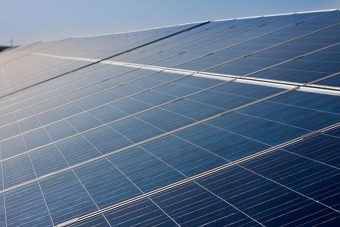
It may not always be sunny in Elgin, but building permits were issued in late May and work is underway on what officials say will be one of the city’s largest solar energy installation.
Rainy Investments is in the midst of having more than 3,700 solar panels installed on roofs on a 12,000-square-foot industrial building along the 1100 block of Davis Road.
According to information provided by Elgin’s Community Development office, “the panels will generate approximately 1.2 megawatts of electricity, and this renewable energy can then be purchased by users at a below-market rate.”
That amount is enough electricity to power approximately 170 single-family homes, according to information provided to Elgin by Commonwealth Edison.
Community Development Director Marc Mylott said the project was made possible in part by City Council adopting a comprehensive solar energy ordinance in November 2014 and the state of Illinois passing the Illinois Future Energy Jobs Act. Gov. Bruce Rauner signed the act into law last year, and it went into effect June 1.
“We 100 percent wouldn’t be doing the Elgin project without the Future Energy Jobs Act,” Ken “Bucky” Buckman said. Buckman is CEO of Rainy Investments, which owns and operates the building, and CEO of Rainy Solar Investments, which owns and operates the roof and solar plant project related to it.
According to reports, the act allows Commonwealth Edison to have a 0.195-cent-per-kilowatt-hour charge that ComEd’s parent company, Exelon, said is needed to keep two nuclear power plants open. At the same time, it also creates a pool of money, made by utility companies charging and collecting 0.189-cents-per-kilowatt-hour, that is to fund alternative energy projects.
According to the Citizens Utility Board the new law will invest $750 million in programs that incentivize solar and wind energy development, provide training for new energy jobs and help low-income, seniors and disabled military veterans cover their utility bills.
Buckman said the financing of his project also involves the federal Solar Investment Tax Credit program. The Solar Energy Industries Association website states the program offers a 30 percent tax credit for solar systems on residential and commercial properties.
Thomas Russe, senior vice president private banking at Sterling Bank in St. Charles said he has assisted Buckman on other endeavors along with the complicated financing involved in a startup project in a budding industry.
Buckman said, “The Elgin Community Development office and its director, Marc Mylott, have been key to helping us smoothly get the project going, too.”
Buckman, who lives on Elgin’s far west side, describes himself as a “serial entrepreneur” and said he bought the building for $4 million. The roofs project is running $3.9 million for the purchase and installation of silicon solar panels and $400,000 in costs for reinforcing the roofs to support the panels.
One roof being fitted with the panels is 20 or so feet above ground. That roof is flat, Everton Walters said, and a challenge is working around small domes cut into the structure to allow natural light into the building space below it. Walters is president, CEO and founder of WCP Solar Services in Naperville and is overseeing the Elgin project.
The other roof involved is another 30 or so feet above the lower roof. That roof has a slight pitch for drainage. So, while the panels on the lower roof are set at a small angle, those above are put in place flush to to that roof, Walters said.
“This project is a $4.3 million test of the new laws. If all works out, and the model is proven, over the next 9-12 months, we will deploy regionwide on a scale of more than $100 million in projects,” Buckman said. “Of course, whenever a business plan relies on government incentives or programs, that’s rather risky in itself.”
The building has one tenant in place, Meyer Metal Systems, and two other spaces for lease, Buckman said. Ironically, Buckman said, none of the electricity generated above will be used to power the buildings below the solar project.
Weather permitting, installation of the panels should be completed by the end of July, Walters said. Buckman said he hopes to have the Elgin-generated energy feeding into the grid within 3 to 6 months past that, but he has built a window of a year into his planning, given that the state’s act is new and his will be one of the first projects to take advantage of it.
Of Buckman’s project, Elgin Mayor Dave Kaptain said, “It’s the wave of the future. Businesses get that. We have people employed in solar and wind energy in Elgin. We don’t have anybody employed in coal.”
Source: chicagotribune.com



